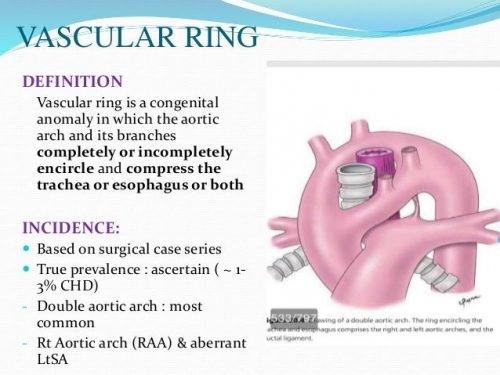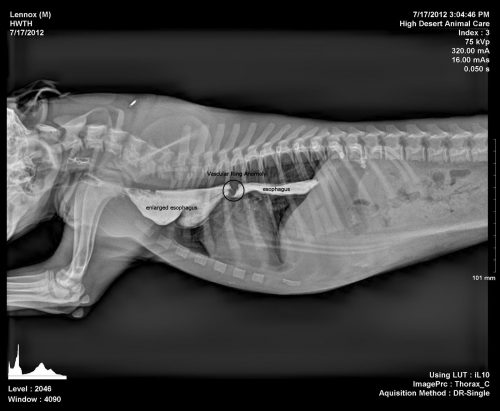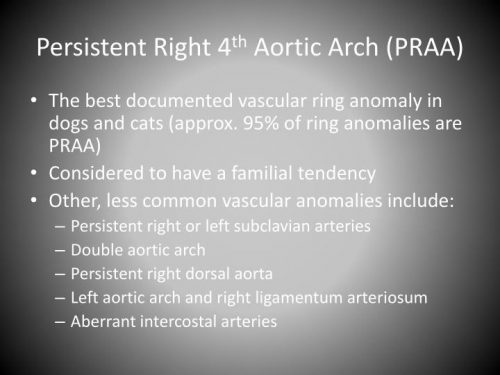What are Vascular Ring Anomalies:
Studies show that the most common vascular ring anomaly found in canines is the aberrant right subclavian artery. This does not produce clinical signs. The persistent right aortic arch, which is the malformation clinically represented in over 90% of canines, forms a complete ring around the esophagus, narrowing the passage. The aorta, which would normally form as the main blood vessel leading from the heart, instead results in a ring around the esophagus, leading to a constriction that can become serious. Predisposition has been found in Boston Terriers, German Shepherds, and Irish Setters. In the fetal stages of development, there are aortic arches (blood vessels) that encircle the esophagus and trachea. In some instances, arches can form in an abnormal way or location, resulting in pressure on the esophagus and trachea, which can cause a narrowing of the organs and subsequent regurgitation of solid food as a puppy is weaned.


Definition of Vascular Ring Example of what it looks like on a dog’s X-ray
Symptoms of Vascular Ring Anomalies in Dogs:
Vascular ring anomalies are most commonly seen in puppies because the affliction becomes apparent as they begin to eat solid foods. However, the possibility is there for the disorder to be diagnosed years later in some dogs. Regurgitation of undigested food, minutes to hours after eating Constant, ravishing hunger Emaciated in shape Stunted growth Aspiration pneumonia (inhalation of mucus, food and water) is a secondary complication that presents with difficulty breathing, rapid heart rate and coughing Types Persistent right aortic arch – most common in canines and causes the vascular ring anomaly that causes regurgitation Double aortic arch – narrowing of the windpipe Left aortic arch – less common and leads to both incomplete and complete vascular ring
Causes of Vascular Ring Anomalies in Dogs:
Though not yet proven, it is thought that the vascular ring anomaly has a hereditary component. No genetic defect marker has been identified, but it is known that multiple puppies from the same litter can have the condition. During the fetal stage, blood vessels develop in an incorrect location, or in an aberrant form and cause a constriction of the trachea and esophagus The vessels, as they matured, should have regressed or reconnected differently Instead, a complete or incomplete ring of vessels encircle the trachea and esophagus Typically, the circular band prevents solid food from passing through the esophagus.
For more detailed information on PRAA and the other, less common strictures named above: See chapters called Persistent Right Aortic Arch (PRAA) and Strictures.
Treatment of Vascular Ring Anomalies in Dogs :
There are three options that are normally considered for this condition.
1. Feeding your puppy as directed for megaesophagus – This involves feeding your puppy more often than usual, small meals of food that have been liquified or made into a very soft texture, while keeping the dog at an elevated position. This involves keeping them upright for some time after eating. Because canines diagnosed with megaesophagus (weakened motility) quite likely will grow out of it, this is an option for them as they mature. However, as a permanent solution for vascular ring anomalies, it may be difficult.
2. Using a gastric feeding tube – When surgery is not a possibility, an option is the gastric feeding tube, whereby the food bypasses the esophagus and goes straight to the stomach. This is often considered as an option for an older dog whose esophagus and trachea are permanently malformed due to maturity. Many dogs live a good quality of life with this alternative, once the adjustment has been made to eating this way.
3. Surgery to correct the anomaly – Surgery is thought to be the best option but is not without its complications as well. This treatment is best done on young puppies, specifically because as the puppies mature, the risk for permanent damage increases. Surgical options include thoracotomy (opening of the chest) and thoracoscopy (less invasive option for easier cases, done by incision and camera). The earlier the better for a successful surgery. However, the risks involved with anesthesia in animals under the age of 2 months must be considered. In addition, if the extent of the esophageal constriction or stretching is severe, a degree of regurgitation can persist.
The condition of your beloved pet, before any options are considered, is a factor. Medical care for conditions like malnourishment or aspiration pneumonia must be evaluated and administered first.
Recovery of Vascular Ring Anomalies in Dogs:
Your veterinarian will provide detailed instructions as to the care of your pet once you and your puppy are ready to start the homecare. If surgery was performed, exercise will be restricted for at least three weeks. The feeding of a liquid diet will be required for weeks afterward, with the re-introduction of soft or mushy foods determining the prognosis for the future. You must be aware that some amount of regurgitation could remain. The prognosis for successful treatment and recovery of vascular ring anomalies depends on the age of your canine companion, the degree of the problem at time of diagnosis, his condition upon arrival at the clinic, and the presence or non-presence of aspiration pneumonia. Frequent communication with the veterinary team will be necessary. Never hesitate to contact the clinic with any concerns about the feeding procedures, whether it be gastric tube or upright feeding. In the case of surgical recovery, keeping the veterinarian informed is an important part of determining the success of the operation. Due to the suspected hereditary component, breeding of a dog with a vascular ring disorder, as well as the breeding of an unaffected littermate, is discouraged.
From a veterinarian experienced with ME: “I just attended a WONDERFUL gastroenterology seminar given by Dr. Mike Willad, in which he spent some time discussing the pros and cons of performing endoscopy on dogs with megae. Until hearing his lecture and seeing his slides, I had frequently counseled that if the barium x-rays are “obvious” for megae, that there is probably little one can learn by doing endoscopy. WRONG. Dr. Willard showed x-rays of dogs that OBVIOUSLY had a Vascular Ring Anomaly (VRA), but, when the surgeon went in, there was no VRA, but rather, the dog had a stricture that did NOT require opening the chest to treat. He also showed, especially in older dogs, that there can be tumors that can only be diagnosed w/ endoscopy. So, the bottom line is, endoscopy may indeed be something to consider on these dogs. In the suspected VRA dogs he suggests that once the dog is anesthetized for surgery, before opening the chest, the surgeon should consider doing a quick scoping to make sure that something else is not going on. Pretty crummy to have the chest opened only to find that THAT was the wrong procedure.”

